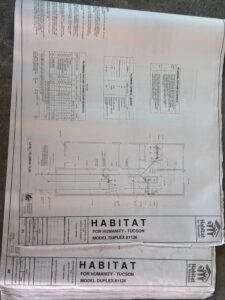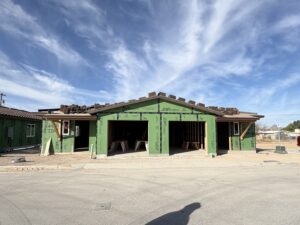Week Three: The Envelope
Emilia K -
Hi everyone, and this week in my effort to build a sustainable home, I took a trip to Habitat for Humanity’s construction site on Nogales Hwy. As I continue to explore sustainable home design, I was interested to see real-world construction in progress. My trip provided valuable insights into the practical challenges and solutions in sustainable building.
Construction Plans

The first image shows the construction plans for Habitat’s Model Duplex #1126. These detailed blueprints reveal how carefully planned every aspect of construction must be. During my initial meeting with Jeff at Habitat for Humanity, we discussed how orientation and positioning serve as passive sustainability measures. In response, I carefully tracked the sun on the parcel of my case study to determine optimal orientation. I want my house to be away from direct sunlight,, especially in the Arizona heat. In Habitat for Humanity’s plans, you can also notice the careful consideration of plumbing fixtures and connection details – elements at first I thought were mundane but are actually crucial for resource efficiency. Plumbing and electricity is something I will continue to research this week to implement into my layout before building.
Framing

The interior photos reveal the wood framing and insulation being installed. The purple material visible on the walls is a fire-proof material that will prevent fires from spreading from one side of the duplex to the other. While this specific step won’t pertain to my single-family home design, I’m going to spend some time this week researching more sustainable alternatives. I noticed how the framing creates space for insulation while maintaining structural integrity.

Insulation
This photo shows the exterior of one of the duplex units under construction. Notice the green ZIP System sheathing, which provides both structural support and serves as an air and water barrier. There is another way to insulate the house, via wrap. However, that process is more complicated, and because Habitat for Humanity relies heavily on volunteer work, an aspect they must consider is teachability in constructing a house. The ZIP System is incredibly effective, which is important because it lessens the strain on the HVAC system, thus using less energy. So not only is it cheaper, it’s more sustainable. High-quality insulation is one of the most cost-effective sustainability measures in a hot climate like Arizona’s, often providing better returns than more visible technologies like solar panels.
Next Steps
The Habitat for Humanity site visit reinforced that sustainability isn’t just about flashy technology – sometimes it’s about smart, simple design decisions like good insulation and perfect orientation that make the biggest difference in both environmental impact and long-term affordability.

Comments:
All viewpoints are welcome but profane, threatening, disrespectful, or harassing comments will not be tolerated and are subject to moderation up to, and including, full deletion.